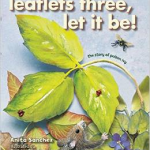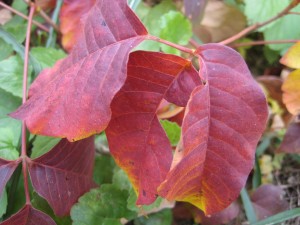 Yes. Really. I’m not kidding. An entire book about poison ivy.
Yes. Really. I’m not kidding. An entire book about poison ivy.
Leaflets Three, Let It Be!: The Story of Poison Ivy, with gorgeous illustrations by Robin Brickman, published in April 2015 by Boyds Mills Press.
And whenever I tell people that I’ve written a book about poison ivy, they stare amazed, then suspicious. Why a book about poison ivy?
This is why:
Usually a class of fifth-graders bounce and chatter like a flock of starlings on a spring day. But this group shuffled behind me, talking among themselves in low murmurs. The closer we got to the head of the trail, the quieter they got.
A girl with a purple leggings and a pink top sidled up next to me. “So are we, like, going into the woods?” she inquired. Her nametag had “Vanessa” written on it with swirls and curlicues around the letter “V.”
“Yep,” I said.
Vanessa looked doubtfully at the green line of trees ahead. “Like, way in the woods?” she asked.
“Way in,” I agreed.
“Oh,” she said, biting a fingernail. “I’ve never been in the woods.”
“Never?”
“Well, we went in a little way once, but my mom got poison ivy.”
Not long ago, I was an educator at a small suburban nature center. Every spring, big yellow schoolbuses would converge on the place, bearing school classes for their annual field trip. My job was to lead the groups of students on nature walks.
And over the years I worked there, I noticed something. Every year, it got harder and harder to convince kids to go into the forest.
Oh, they were still enthralled by the birds and trees and the rippling stream, once they got started—but increasingly, it was hard to convince them to leave the parking lot behind, no matter how many times I assured them everything was perfectly fine.
Of course, assuring a kid that everything is “perfectly fine” doesn’t work. Wary from years of vaccinations, dentist appointments, and standardized tests, kids know just how trustworthy that statement is. But adults never learn.
“Oh, it’ll be fine!” I told Vanessa breezily. “Don’t worry, I’ll show you just what poison ivy looks like. It has three leaves so it’s easy to identify.”
“Oh, my God, you don’t have poison ivy here, do you?” The high-heeled chaperone, just behind us, turned pale. “Oh, my goodness, boys and girls, I had poison ivy once, and I’ll tell you, it was terrible. My skin got all red and itchy and the blisters were as big as eggs, and…”
“Yes, well, here we are at the trailhead,” I broke in. “We’ll start the nature walk now.”
“Now remember, boys and girls, stay in line,” the chaperone hissed. “Keep your hands at your sides and don’t touch anything. Once you get poison ivy, it spreads all over, and there’s no stopping it. Now keep a sharp eye out for plants with three leaves.”
“Three leaves, right.” Vanessa frowned at a maple tree. “But there’s three leaves on this branch, and three leaves on that branch–and look, that branch over there has five or six leaves. So this must be poison ivy.”
“Just don’t touch any leaves!” the chaperone insisted. “And stay right in the middle of the trail. Only the ranger knows what’s safe to touch. I tell you, the blisters were the size of golf balls…”
No wonder kids like to stay inside and play video games. At least indoors you know what’s safe to touch.
Children can only learn what they’re allowed to experience. And in case you haven’t spent any time in a classroom recently, I’m sorry to report that children aren’t being taught the ABC’s of the forest. There are no standardized tests on watching woodpeckers or cardinals, no pop quizzes on how to find salamanders. It seemed to me that Vanessa—and all those thousands of children standing fearfully in the parking lot—need some help in learning how to go out in the woods and mess around and climb trees and watch tadpoles and all that stuff that textbooks leave out.
So. That’s why a book on poison ivy.
And there’ll be a quiz at the end of the period.





This is one of your most frightening posts. Speaking as someone who does not have kids, I think we (society) is overprotective these days.
we pre-ordered and can’t wait to read it!
thanks for sharing!